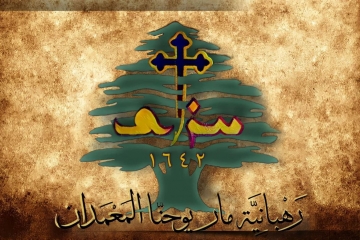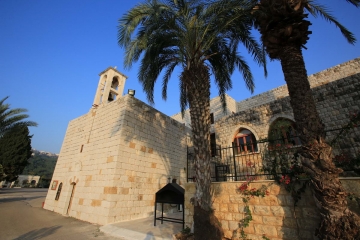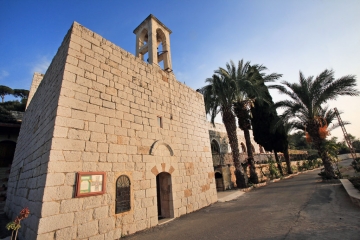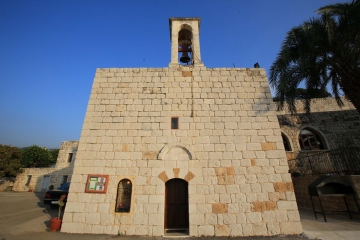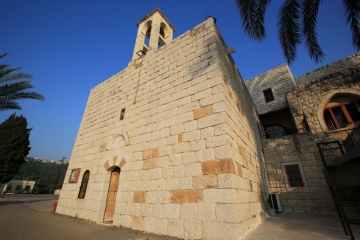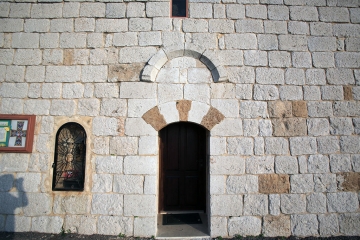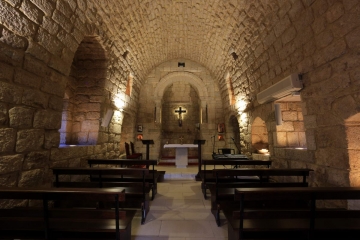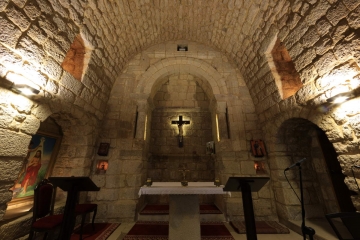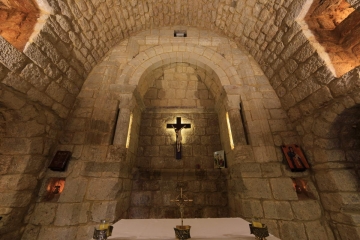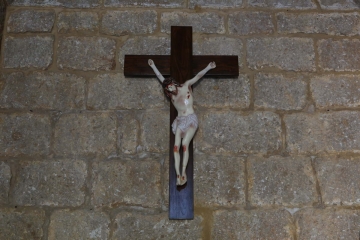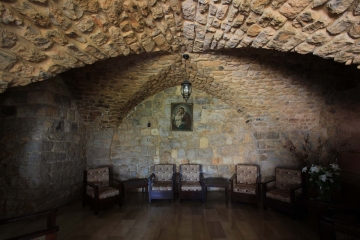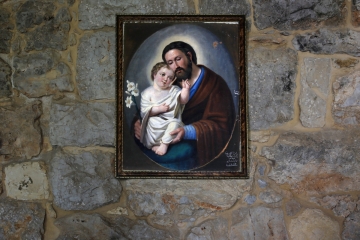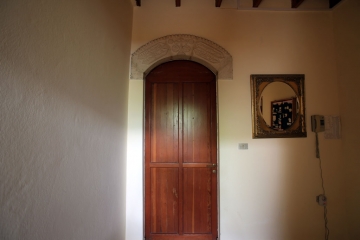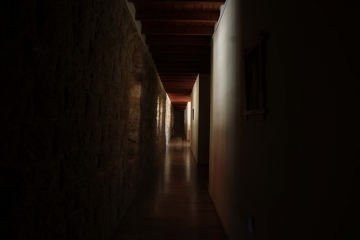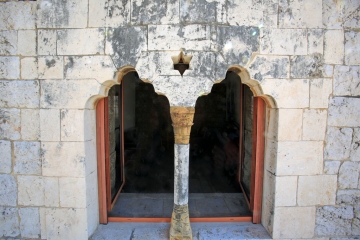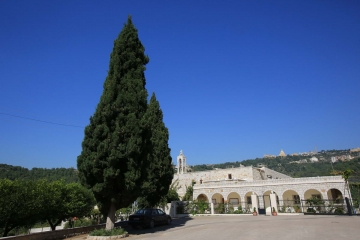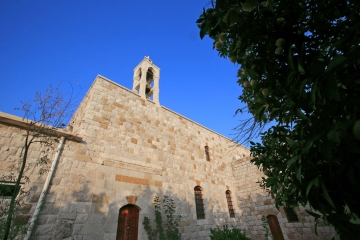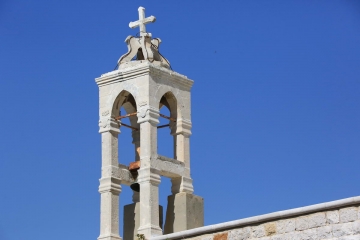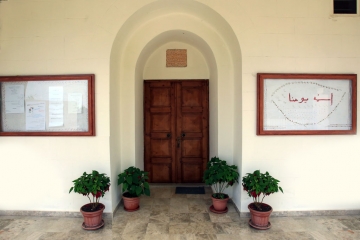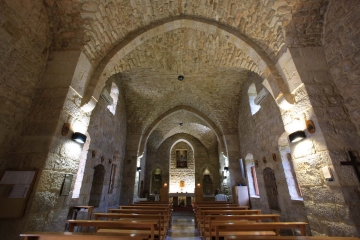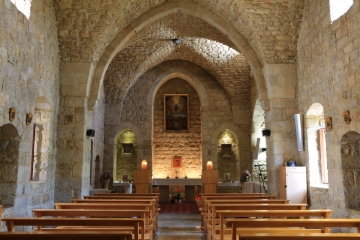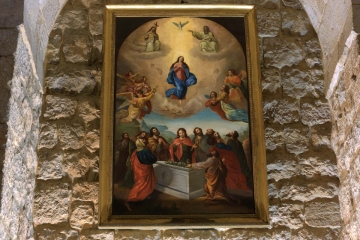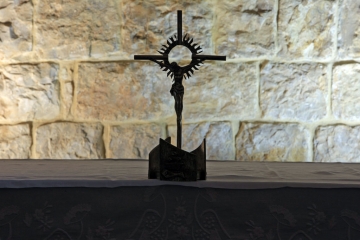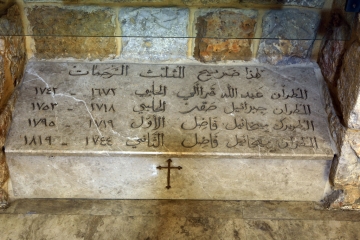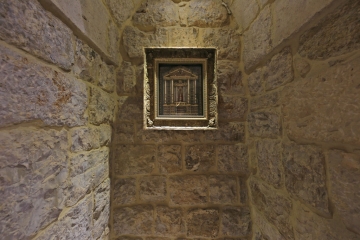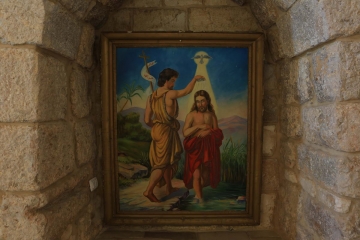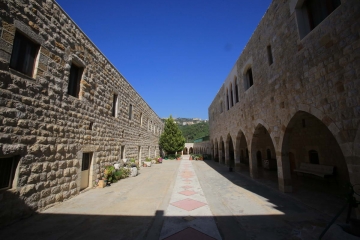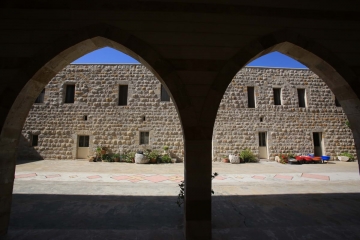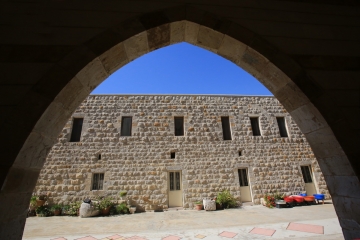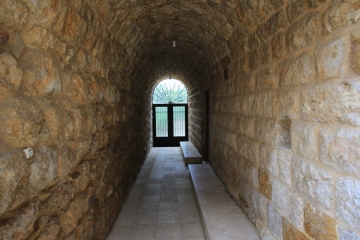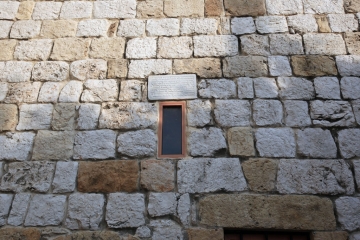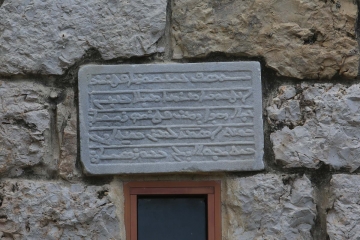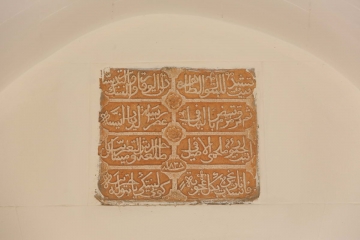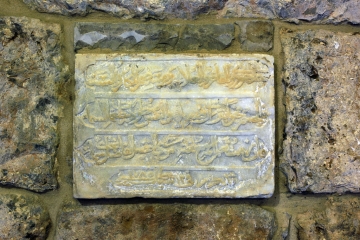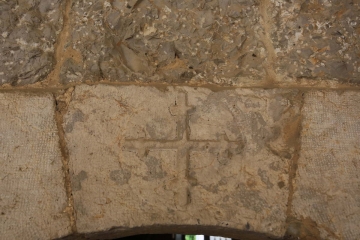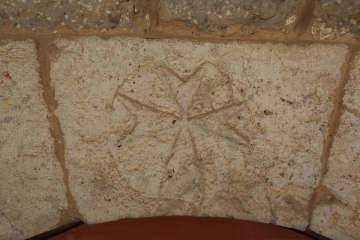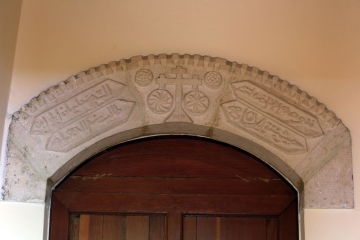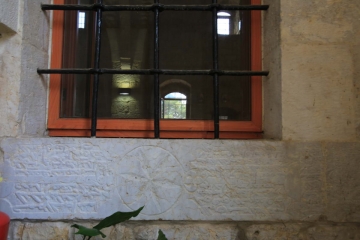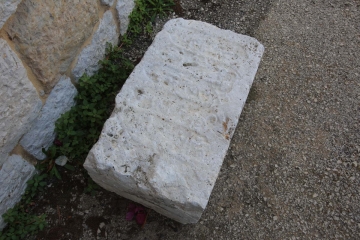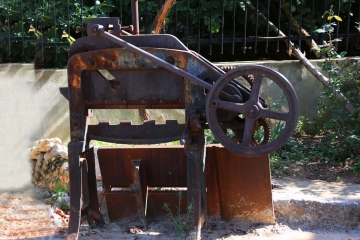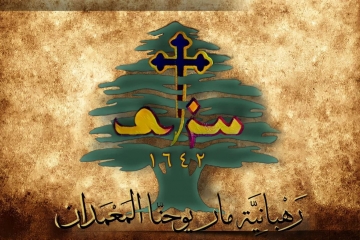دير مار يوحنّا – حراش
يَقَع هذا الدير في مُنخفَضٍ ما بين درعون وعينطورة، ويُنفَذ إليه من ناحية عينطورة - عين الريحانة، وكلمة "حراش" تعني الخرس والسكوت.
يَذكُر البطريرك إسطفان الدويهي، في "تاريخ الأزمنة"، أنه في العام 1642 اشترى الأسقُف يوسف حليب العاقوري، وذلك من الشيخ يوسف أبي حبيش، أرض مار يوحنّا حراش في ناحية درعون بكسروان.
وفي العام 1642 بَنى ديراً سَكَن البنات اللواتي يُرِدنَ خِدمة الله، وأسَّسَ لَهُنَّ جَمعية رهبانية جَعَل مَقرَّها الوحيد، ومَركز رئاستها العامة، هذا الدير. وقد وَصَل عدد الراهبات إلى ثلاثين، وكانت رئيسَتَهُن الأخت رفقة ابنة الخوري يوحنّا المحاسب من غوسطا، وقد تَخَصَّصن بالسِريانية واهتَمَمن بِنسَخ الكتب الطقسية. وكان هذا الدير أول دير نِسائي بين أديار كسروان في القرن السابع عشر، وقد تأسَّسَ بِمُبادرة أسقف وليس بمبادرة عائلة كما جرت العادة، ولم يَكُن في انطلاقته من الأديار المُزدوجة. وقد بَنَى مؤسِّسه فيه لاحقاً كنيسة على اسم السيّدة العذراء، وذلك تيمُّناً بها لِكَونه قد أنتُخب بطريركاً يوم 15 آب 1644 أي يوم عيدها.
ونورِد في ما يلي نَص صَك الشِراء من آل حبيش كما ورد حرفياً بخط يد الواقف والمثْبَت في سِجل دير سيّدة قنّوبين.. حيث نقرأ:
"حَضَرت أنا الحقير إلى عند سيّدنا البطريرك جرجس عميره، وانحنيتُ قدِّام أقدامِه وقبَّلتُ أيديه المُقدَّسة وقُلتُ له: أنا الحقير في الرؤسا يوسف العاقوري مُطران مدينة صيدا أريد أن أوقف مَزرعة حراش قدِّام قداسَتِكم لأجل الراهبات، وعَلِّم عشر صُبيان القاطنين في مار يوحنّا المَعمدان بحراش المُشتريه من مالي ومال ابني المرحوم الشِدياق إيلياس من المُكرَّم أبي حبيش، وقفاً ثابتاً إلى أبد الدهور، وخَطّ يديّ يَشهَد عليّ"، ويتبيَّن لنا من كلامِه هذا أنه كان مُتأهلاً ورب عائلة.
وقد دَبَّج الأب يوسف الشبابي، أحد مُدبّري الرهبانية المريمية المارونية التي كانت تُدعى يومئذٍ "الحَلبية"، كتابةً علَّقها بخط يده على سِجلّ الدير، ناقلاً إياها، على ما يقول، دون تحريف، عن كتابٍ مخطوطٍ قديم مُسطَّر بِخَط يد المؤسِس الواقف، أي البطريرك يوسف العاقوري (1644-1648)، وهي من باب الزَجليات، وبِمثابَة قانون للدير، وهذا نَصُّها:
اشتريت حراش مِتل ما هيِّه من مَشايخنا الحبيشيِّه
بماية وأربعين غرش كُلَيبيِّه
وهي من الشيخ حبيش عظيم الشاني
اشتريت حراش وعَمَّرت به قلالي وحواش
وأوصَيت راهباته لا تنام بفراش
طوال الدهر والزَّمانِ
وأن لا يقبلوا أرملة تَسكُن به ولو كانت تَروي البرهاني
عَمَّرته من مالي لنفسي صدقه عنّي وعن ابني
وعن أبي المطران بطرس ومَن تشوتف مع المطراني
اشتريت توت بأرض عينطورا مع توت في حراش عند الطاحوني
وتوت الدقيق بتلاتماية غرش من الفقير المسكيني
ونَصَبتُ ألف توته في الوقت
ووقفت ما اشتريت بالوقت
وقفاً مخلَّداً ثابتاً، غير مسموح لأحد أن يبيعَ منه شيئاً
ومَن تَعَدّى عليه بشيء وغيَّر الوقفيّه تَحلُّ عليه الحُرومات الربّانيّه
حتى ولوَ على الذي يقول:" لي فيه ملكيِّه"
ماري حنّا المعمدان دَيرُه عَمَّره المُطران
سنة ألف وستمائة كان
وإتنين وأربعين ربّاني
وفي ما خَصَّ راهبات الدير، فقد ظَلَلّنَ حَبيسات حتى مُنتصف القرن العشرين، حيث تَحوَّلن من الإحتباس الصارِم إلى الحياة العملية الرسولية. ففي العام 1942 أعطى البطريرك أنطون عريضة (1932-1955) الإذن للراهبات بالتوجه لعمل الرسالة، فبدأنَ بالعمل ضِمنَ المؤسسات التربوية والروحية، ومنها المدارس الخاصة والإكليريكية، وذلك في عِدَة مناطِق من لبنان وسوريا.
وبعد أن تلقّى بَعضَهنَّ العلوم الجامعية، أسَّسنَ مدرسةً جُعلت، كالدير، على اسم مار يوحنّا المعمدان، كما أقمنَ مركزاً للتعليم المسيحي.
أما لِجِهة بناء دير مار يوحنّا حراش القديم قبل شرائه، فيعود إلى العام 1570، وتدلُّ على ذلك اللوحة المَنحوتة فوق أحد الأبواب:
" قد عمَّر هذه الأوضة لنفسه سليمان الحاج إبن حبيش سنة 1570، وهو طالب مِنكم السَماح".
ودير حراش هو، في الواقع، عِبارة عن دَيرين مُتجاورين، أحدهما كان مَقاماً لرهبان مار يوحنّا حراش، الذي أصبح فيما بعد مقراً لأسقفية بيروت وصربا ودمشق، ليُصبِح مع البطريرك يوسف حليب العاقوري كرسيّاّ بطريركيّاً والثاني مقراً للراهبات. بينما اليوم أصبح الدير الأول ديراً للإبتداء، والثاني مركزاً للرئاسة العامة لرهبانية مار يوحنّا المعمدان - حراش. والديران المَذكوران هما تَحتَ عناية الرئيسة العامة للرهبانية.
قلاّيات الدير الأول ما زالت قائمة، وقد أضيفت اليها أجنِحة. ويَلفُت النظر في كنيسته أن العامودين القائمين على جانبَي المذبح يوحيان بأنهما يعودان إلى عهدٍ سابق لقيام هذا الدير، ورُبما كانا في معبد قديم فنُقلا منه إلى الكنيسة الحالَّية. ومِثلِ ذلك نَستطيع أن نُلاحظه في الحِجارة المُتَعرِجَة التي تعلو المذبح. كما يوجد على الحائط الداخلي للكنيسة لوحة حُفرت عليها أبيات شِعرية وكأنّها رثاء، حَيث نقرأ بين أسطُرِها:
...المفاخر والعلا ... ضمًّ المَكارِم
...الجسم ...أرضية...والنفس منظومة بطغمات السما
...موسى الفضيل الفاضل ... سما
حُرر في 13 شباط 1785
أمّا في ما يتعلَّق بالدير الثاني، وهو حالياً دير الرئاسة العامة، فتُطالِعُنا على مَدخل كنيسته لوحة تَعلوه، مؤرَّخة في العام 1838، عام تَرميمه، وهي تَحمِل الأبيات الشعرية التالية بلغةٍ بدائية:
بيت تشيَّد للبتول الطاهره ذات الوقار والنسك والقدّيسا
ثمّ ترمرم وتبيَّض بالبها في عصر ريّسة الديار انيسا
بنت الجبور ملحم الاصيل في طلعة حراش ومساكن التعر..
فانشدت تاريخي بكل عجوبة كونى لبيتكي يا بتوله حريسا
1838
كما يَلفُت النَظَر في هذا الدير، أن كنيسته تَضُم مَدفناً يثوي فيه البطريرك ميخائيل فاضل (1793-1795) مع جَثامين ثلاثة مطارنة هم: المطران عبدالله قَرَاألي الحلبي، والمطران جبرائيل صقر الحلبي، والمطران ميخائيل فاضل الثاني.
وهذه الكنيسة غنيَّة بالذخائر، مِنها لعود الصليب وغيره. وللمُصادفة أنه على قِبَّة جَرَس الكنيسة، نُقشت العبارة التالية:
"باعتناء الأم تاودورا الحُويّك سنة 1907"، وهذه الراهبة هي شقيقة البطريرك مار الياس بطرس الحويّك (1899-1931).
ويُلاحَظ أن العَتَبة السُفلى العائدة لإحدى نوافذ هذه الكنيسة تَحمِل كتابةً بالسِريانية مَوضوعة بِشكل معكوس، كذلك يوجد على الحائط الغربي للكنيسة توجد منحوتة حيث نقراء عليها:
يوسف من عين قوريو بطريرك أنطاكيا الماروني الحقير بزمننا البيعة قاد السيد بطرس رأس الرسل بسنة ١٦٤٤ لسيدنا بسنة ٦٨٤٤ لآدم بجلوسنا بكرسينا.
والترجمة الصحيحة:
يوسف الحقير بالله من عين قوريو بطريرك أنطاكيا الماروني، قاد بيعة مار بطرس رأس الرسل بزمننا سنة ١٦٤٤ ميلاديّة و ٧٦٤٤ آدمية. عن كرسيّنا.
بطاركة دير حراش
البطريرك يوسف حليب العاقوري (1644-1648)، وهو ابن المطران بطرس بن حليب ابن الخوري سابا العاقوري، إذ كان المطران بطرس مُتزوجاً قبل إرتقائه إلى الدرجات المُقدسة، ثم توفيت زوجته، كما جاء في "الجامِع المُفصل في تاريخ الموارنة المؤصل" للمطران الدبس.
وعلى أثر وفاة البطريرك جِرجِس عميرة الإهدني في العام 1644، جَرى انتخاب مطران صيدا يوسف حليب العاقوري (1644-1648) خَلَفاً له، وذلك في دير سيّدة قنّوبين، ولَكِنه جَعَل مَقرّ إقامته في الدير الذي بناه: مار يوحنّا المعمدان، الذي أصبح يُعرف بدير مار يوحنّا حراش، إلا أنه كان، في الواقع، يَتَنقَّل بينه وبين دير قنّوبين، كما أقام، لفترةٍ، في دير مرت موره في إهدن.
ويروي البطريرك الدويهي في "تاريخ الأزمنة" أنه، في العام 1645، أرسل البطريرك يوسف العاقوري القَس عبد المسيح الحَدثي والقس بطرس مخلوف الغسطاوي ليرمي الطاعة للبابا إينوشنسيوس العاشر (1644-1655)، ويطلب منه التثبيت كجاري العادة، كما إلتمس طَبِع الشحيمة الصغيرة والغراماطيق الذي صَنَّفه في اللغة السريانية، فوافق البابا على طلبه، وأرسل له عدَّةً كاملة مع التثبيت ودِرع الرئاسة السامية.
عَقَد هذا البطريرك مَجمَعاً في دير حراش، في 5 كانون الاول 1644، برئاسته، وكان الهَدَف مِنه إعادة الكنيسة المارونية إلى تقليدها المَشرقي وعوايدها القديمة في مواجَهة التأثير اللاتيني المُتصاعد. دُعي هذا المَجمَع مَجمَعاً ملّياً، وكانت المواضيع التي عالجَها تَتَعلَّق بالأسرار البيعية من إعترافات وعقود زواج، وبالقضايا الكهنوتية ومَسحة المَرضى، ثم بالميراث.. ووصايا الكنيسة المُختلفة من أعيادٍ وصوم وسوى ذلك...
توفي البطريرك يوسف حليب في 3 تشرين الثاني سنة 1648، ولكنَّ ليسَ من مرجعٍ تاريخي يُحدِّد مكان دَفنِه بالضبط. وبوفاته خلا دير مار يوحنّا – حراش من سَكن البطاركة فيه حتى جاء البطريرك ميخائيل فاضل في العام 1793، أي بعد 145 سنة من وفاة البطريرك العاقوري، فَسَكن هذا الدير كما سيرد في ما يلي.
البطريرك ميخائيل فاضل (1793-1795).
سَلَفَه كان البطريرك يوسف إسطفان (1766-1793) من غوسطا، جَرى انتخابه في 9 حزيران سنة 1766 في دير مار شلّيطا مقبس.
وُلد البطريرك ميخائيل فاضل، حَسبَ ما كتب بخط يده، في إيالة صيدا سنة 1719، والتحق بالمدرسة المارونية في روما سنة 1729، وعاد منها في 24 حزيران سنة 1740. سيم كاهناً على يد البطريرك يوسف ضِرغام الخازن في دير مار شلّيطا مقبس، فَخَدَم في البدء رعية مدينة عكا، ثم انتقل إلى خِدمة رعيّة بيروت.. وظل فيها إلى ان أصبح مطراناً. وفي أثناء خِدمته رعية بيروت تَسلَّم تدبير دير مار يوحنّا حراش، مُعتنياً في البدء بأمور راهباته الروحية، ثم راح، على الأثر، يُعنى بأمورهنَّ الزمنية.
وفي حزيران سنة 1762 رُقّي إلى درجة الأسقفية، وكتب عن ذلك يقول: "في اليوم الثالث عشر من شهر حزيران سنة 1762 ارتسمت من البطريرك طوبيا الخازن مطراناً على دير مار يوحنّا حراش ووكيلاً على الكرسيّ الأنطاكي، وجرى ذلك في كنيسة مار جرجس ببيروت، وذلك بحضور ووضع يد أربعة مطارين مع قِدسِه"، وهذه السُطور وَرَدَت بقلمه في بداية مخطوطٍ بعنوان: "كتاب مَجموع دفاتر دير مار يوحنّا حراش".
يُستفاد مما ذُكر أعلاه أنه بدأ بتدبير أمور دير مار يوحنّا حراش منذ أن كان كاهناً، مع خِدمتة لرعية بيروت، وتابع ذلك بعد أن أصبح أسقفاً. وهنا لا بُدَّ من ذِكر ما كتبه بَعض الذين تذوَّقوا خِصاله الحميدة ومناقبه الجميلة: "من بعد ارتقائه إلى درجة المطرانية، إبتدأ هذا السيّد الغيور في تهذيب وترتيب ديره المذكور في الأمور الروحية والجسدية". لكنَّ هذا الكاتب نفسَه يعود فيقول: "تسلَّم الأب المذكور (أي الكاهن) تدبير دير حراش في اول ايلول 1758 بأمر السيّد البطريرك مار طوبيا الخازن، بِموجب إلتماس من رهبان وراهبات الدير المذكور.. مع المشايخ أيضاً. ففي السنة المَذكورة دَبَّرَ الدير في الإرشاد الروحيّ لا غير، وبعد نهاية تلك السنة دبَّر الدير روحاً وجسماً". أما المطران نفسه فيقول: "لَمّا كان تاريخ سنة 1760، في غرَّة كانون الاول، أنا الحقير المطران ميخائيل فاضل، تَسلَّمتُ تدبير ولاية دير حراش من قِدس سيّدنا البطريرك مار طوبيّا بطرس الخازن".
وظلَّ في هذه المُهمة حتى العام 1793 عندما انتُخب بطريركاً، إذ في العشرين من أيلول من ذلك العام إفتُتح المجمع الإنتخابيّ، وفي اليوم التالي، الحادي والعشرين منه، تم انتخابه، اذ كان قد تأخَّر إجراء هذا الانتخاب بِسَبب تَفشّي مَرَض الطاعون...
وأقرَّ الأساقفة المُجتمعون شَرعية انتخابه وتَعَهَّدوا له بالطاعة والخضوع، فأرسل غبطته الخوري جرجس غانم إلى رومية ليقدّم باسمه الطاعة للبابا بيوس السادس (1775-1799)، ويَلتمِسُ له منه التثبيت الرسولي على الكرسيّ الأنطاكي والدِرع الحبري، ولكنه رَقَد بالرب قبل أن يصِل الخوري المَذكور إلى عاصِمة الكثلكة، ويطلب له براءة التثبيت والدِرع المقدَّس. إلا ان البابا أراد، إستناداً إلى شرعية انتخابه، إدراجه في عداد البطاركة الموارنة، فَعَمَد إلى مَنحِه دِرع التثبيت بعد الوفاة، وذلك في الديوان السِرّي الذي انعقد في 27 حزيران 1796، ومِمّا قاله في هذا المجال: " لَمّا كانت غِيَر الزمان لَم تَسمح لنا بأن نَمنَحَه التثبيت وهو حيّ، نمنحه إياه وهو ميت، ونُريد ان يُحصى في سِلسِلة بطاركة الموارنة ولو أحرمته المنِيَّة قبول زينة دِرع الرئاسة".
أجل، توفّي البطريرك ميخائيل فاضل في دير حراش يوم 17 ايار 1795.. ودُفن فيه، ويوجد على المدفن لوحة رخامية تؤرخ وفاته بالاضافة إلى المطارنة الثلاثة المذكورين آنفاً، مع ذكر سنة ولادة كل من البطريرك والمطارنة وسنة وفاتهم.
وأرَّخ وفاته المُعلّم الياس إدّه في المقطوعة الشعرية التالية حيث جَعَل الكلمات الواردة بعد كلمة "تاريخه" تساوي بِحساب الجُمَّل، السَنة التي حَضَنَت مَوته:
هذا ضريح العالِم البارّ التَّقي
والحبر ميخائيل فاضل مَن سما
يا صاحِ في تاريخه
"جِدَّ وقل" 7 + 136
"بكماله لا غروَ قد نال السَّما" 98 + 31 + 1206 + 104 + 81 + 132
المجموع: 7 + 136+98 + 31 + 1206 + 104 + 81 + 132 = = 1795
يُذكَر أن حِسَاب الجُمَّل هي طريقة لتَسجيل الأرقام والتواريخ بإستخدام الحروف الأبجدية، إذ يعطى كلَّ حرفٍ رقماً مُعيناً يَدِلُّ عليه. فكانوا من تَشكيلة هذه الحروف ومَجموعها يِصلون إلى ما تعنيه من تاريخ مقصود، وبالعكس كانوا يستخدمون الأرقام للوصول إلى النصوص.
وجاء في المَخطوط الذي عنوانه " كتاب مَجموع دفاتر دير مار يوحنّا - حراش": " بعد ثلاثة أيام من وفات (وفاة) هذا السيّد الجليل، الحَبر النبيل، كافَّة الإكليروس وأرخندوس الطايفة المارونية شَرَعوا في إحتفال وتكريم جَسدَه الُموقَّر في الجنّازات والزيّاحات بكل تهيُّب واحترام، ثم وَضَعوه في رمسٍ مُكرَّم داخل كنيسة ديرنا بمذبح مار يوحنّا في الحنيَّة الشمالية التي هي على يمين المذبح الكبير المُشيَّد على اسم السيّدة".
كُنّي هذا البطريرك بـ "كَوكَب الشرق" لوِفرة علومه ومَعارِفه، وقد سانَد، في أيام أسقفيته، البطريرك يوسف إسطفان بِحَلّ مُشكلات شائكة بآرائه الفقهية، وَوَضعِه التقاريرالعِلمية الدقيقة حول أحوال الموارنة ومسائلهم القضائية.
فَمَع إقامة كلٍ من هذا البطريرك والبطريرك يوسف حليب العاقوري إقامةً ثابتة في دير مار يوحنّا حراش يُعتبر هذا الدير من المقرات البطريركية المارونية الموقتة.
ويُذكر انه، في الوقت الحاضر، أصبح دير مار يوحنّا حراش في نِطاق بلدة عين الريحانة وليس في نطاق بلدة درعون، وذلك بِموجب تعديلات إدارية على الخرائط العقارية.
Saint John Monastery – Hrash
This monastery is located in a depression of land between Daroun and Aintoura, and it is reached from the direction of Aintoura - Ain al-Rihana. The word “Hrash” means “silence” and “quiet”.
Patriarch Estephan Doueihy mentions, in “History of the Times,” that in 1642, Bishop Youssef Haleeb al-Aqouri purchased the land of Saint John Hrash in the Daruun district of Keserwan from Sheikh Youssef Abi Hobeish.
In 1643, he built a monastery and established a monastic association to accommodate girls who wanted to serve God, making this monastery its sole headquarters, and the center of its general presidency. The number of nuns reached thirty, and their head was Mother Rebecca, the daughter of the priest Youhanna Mohasseb. They specialized in Syriac and were interested in transcribing ritual books. This monastery was the first women's monastery among the monasteries of Keserwan in the seventeenth century. It was founded at the initiative of a bishop and not at the initiative of a family, as was customary, and it was not part of the double monasteries. Its founder later built a beautiful church dedicated to the Virgin, to honor her because he was elected patriarch on August 15, 1644, the day of her feast.
In the following, we provide the text of the purchase deed from the Hobeish family, as it was mentioned verbatim in handwriting in the register of the monastery of Our Lady of Qannoubine:
“I, the wretched, came into the presence of our master, Patriarch Gerges Amira, and I bowed before his feet and kissed his holy hands, and I said to him: I am the most wretched of rulers, Youssef Al-Aqouri, Metropolitan of Sidon. I want to endow the Hrash farm before Your Holiness to the nuns and provide education to the ten boys who live in St. John the Baptist in Hrash, which was purchased with my money and the money of my son, the late Elias, from the honorable Abu Hobeish. Let it be a permanent endowment, forever and ever, and the handwriting of my hand bears witness to this fact.” We can conclude from his words that he was married and had children.
Father Youssef al-Shababy, one of the administrators of the Marian Maronite Congregation, which was called “Al-Halabia” at that time, wrote in the monastery register, quoting without distortion, from an ancient manuscript lined in the handwriting of the founder, that is, Patriarch Joseph Al-Aqouri (1644-1648), a text that attests to the aforementioned events.
With regard to the nuns of the monastery, they remained hermits until the middle of the twentieth century, when they shifted from strict confinement to practical apostolic life. In 1942, Patriarch Anton Arida (1932-1955) gave permission for the nuns to undertake the apostolic mission, so they began to work within educational and spiritual institutions, including private and seminary schools, in several regions of Lebanon and Syria.
After some of them completed their university studies, they established a school that was dedicated, like the monastery, to St. John the Baptist, and they also set up a center for Christian education.
As for the construction of the old monastery of St. John Hrash, before its purchase, it dates back to the year 1570, and this is indicated by the plaque carved above one of the doors: “This room was built by Suleiman Al-Hajj Ibn Hobeish for himself in the year 1570, and he asks for your forgiveness”
The monastery of Hrash is, in fact, two adjacent monasteries, one of which was a shrine for the monks of Saint John Hrash, which later became the seat of the Diocese of Beirut, Sarba and Damascus to become, with Patriarch Youssef Haleeb al-Aqouri, a patriarchal chair, and the second a residence for nuns. The first monastery has become today a novitiate monastery and the second is a center for the general presidency of the Order of Saint John the Baptist - Hrash. The two aforementioned monasteries were under the care of the superior general of the congregation.
The cells of the first monastery are still standing, and wings have been added to them. It is noteworthy in his church that the two columns standing on both sides of the altar suggest that they date back to an era before the establishment of this monastery, as if they were part of an old temple, and were transferred from it to the current church. The same can be seen in the sinuous stones above the altar. There is also a plaque on the inner wall of the church engraved with poetic verses that resemble lamentations:
“The feats and the glory ... the honor
...the body...the earth...and the soul influenced by the heavens
...the most virtuous Moussa … soared
February 13, 1785”
As for the second monastery, which is currently the headquarters of the General Presidency, we see a plaque above the entrance to its church, dated 1838, the year of its restoration, and it bears the following poetic verses in a primitive language:
“A house erected for the pure, revered Virgin, for hermitage, and sainthood
Then repaired and turned white in the era of the abbess, Anisa
The daughter of Al-Jabour, Melhem the honorable, residing in Talaat Hrash and Al-Tarisa
So I sang my story with all its miracles, to be at your house, O virgin, as a guard”
It is also striking in this monastery that its church includes a cemetery in which Patriarch Michael Fadel (1793-1795) rests next to three metropolitans: Archbishop Abdullah Qaraali Al-Halabi, Archbishop Gabriel Saqr Al-Halabi, and Archbishop Mikhail Fadel II.
This church is rich in relics, including a piece of the crucifix and others.
Coincidentally, on the dome of the church bell, the following phrase was inscribed: “With the care of Mother Teodora El Howayek in 1907.” This nun is the sister of Patriarch Mar Elias Boutros El Howayek (1899-1931).
It is noted that the lower threshold of one of the windows of this church bears an inscription in Syriac placed in reverse, and on the outer wall of the monastery, next to the church, there is a plaque with an inscription in Syriac.
There is also a carving on the western wall of the church which reads:
Literal translation: Joseph of Ain Korio, the wretched Maronite Patriarch of Antioch in our time, led Peter the head of the apostles in the year 1644 to our master in the year 6844 after Adam sitting in our chair.
Accurate translation: Youssef the wretched, from Ain Korio, the Maronite Patriarch of Antioch. He took the pledge of allegiance to Saint Peter, the head of the apostles in our time in the year 1644 AD and 7644 after Adam.
The patriarchs of the monastery of Hrash
Patriarch Youssef Halib al-Aqouri (1644-1648), the son of Archbishop Boutros the son of Halib the son of Father Saba al-Aqouri. Archbishop Boutros was married before his ascension to the holy ranks, then his wife died, as stated by Archbishop Debs in his book.
Following the death of Patriarch Gerges Amira Al-Ehdeni in 1644, the bishop of Sidon Youssef Halib Al-Aqouri (1644-1648) was elected as his successor, in the monastery of Our Lady of Qannoubine, but he resided in the monastery that he built: Saint John the Baptist, which became known as the Saint John Monastery Hrash; but he was, in fact, moving between both monasteries, and he lived, for a period, in the monastery of Mart Mora in Ehden.
Patriarch Douaihy relates in “The History of Time” that, in 1645, Patriarch Youssef al-Aqouri sent Reverend Abd al-Masih al-Hadithi and Reverend Peter Makhlouf al-Ghostawi to pledge obedience to Pope Innocent X (1644-1655) and ask him for the usual confirmation shield. He also requested the printing of the grammatike in the Syriac language. The Pope granted his request and sent him a complete kit with the confirmation shield.
This patriarch held a synod in Deir Hrash, on December 5, 1644, under his presidency. The aim was to restore the Maronite Church to its Eastern tradition and its ancient customs in the face of the rising Latin influence.
This council was called a full assembly, and the topics that it dealt with were related to sacraments such as confessions and marriage contracts, priestly issues and the anointing of the sick, and inheritance, as well as the various commandments of the church such as feasts and fasting.
Patriarch Youssef Halib died on November 3, 1648, in his hometown of Aqoura, but there is no historical reference that determines the exact place of his burial. And with his death, the monastery of St. John - Hrash ceased to be the residence of patriarchs, until Patriarch Michael Fadel came to it in 1793, 145 years after the death of Patriarch Al-Akouri, and resided in it.
Patriarch Michael Fadel (1793-1795)
According to what he wrote himself, Patriarch Michael Fadel was born in Sidon in 1719. He joined the Maronite School in Rome in 1729 and remained there until June 24, 1740. He was ordained a priest by Patriarch Youssef Dargham Al-Khazen in the monastery of Mar Shalita Moqbes. He initially served the parish of the city of Acre, then moved to the service of the parish of Beirut, and remained there until he became a bishop. During his service to the parish of Beirut, he took over the management of the monastery of St. John Hrash, initially taking care of the spiritual affairs of his nuns, and then, afterward, their temporal affairs.
In June 1762, he was elevated to the rank of Episcopalian. He wrote about this saying: “On the thirteenth day of June 1762, I was ordained by Patriarch Tobias El-Khazen as Metropolitan of the Monastery of Saint John Hrash and as an agent of the Antiochian See. This took place in St. George’s Church in Beirut, in the presence of four metropolitans.” These lines appeared in his handwriting at the beginning of a manuscript entitled: "The Book of the Collection of Notebooks of the Monastery of Saint John Hrash".
It is mentioned above, he began managing the affairs of the monastery of St. John Hrash since he was a priest serving the parish of Beirut and continued to do so after he became a bishop. It is necessary to mention what some of those who witnessed his good qualities and beautiful virtues wrote: “After his elevation to the rank of Archdiocese, this zealous master began to organize and arrange his monastery’s spiritual and temporal matters.” But this same writer says: “The aforementioned father (that is, the priest) took over the management of the Hrash monastery on the first of September 1758 by order of the Patriarch Mar Tobia the Khazen, according to a petition from the monks and nuns of the aforementioned monastery. In the mentioned year he took over the spiritual affairs of the monastery. Only, after the end of that year, he also took over the temporal matters of the monastery" As for the bishop himself, he says: “In 1760, on the first of December, I, the despicable Archbishop Michael Fadel, took over the management of the monastery of Hrash from our master Patriarch Mar Tobia Peter Al-Khazen.”
And he remained in this position until 1793 when he was elected Patriarch on the twenty-first of September. The election had been delayed due to the outbreak of the plague.
The assembled bishops confirmed the legitimacy of his election and pledged to him obedience and submission. His Beatitude Gerges Ghanem was sent to Rome to pledge in his name obedience to Pope Pius VI (1775-1799) and to seek from him the apostolic confirmation on the Antiochian Chair and the Pontifical Shield, but the patriarch passed away before the aforementioned priest reached the capital of Catholicism. However, the Pope, based on the legitimacy of his election, wanted to include him among the Maronite patriarchs, so he proceeded to give him the shield of confirmation post-mortem, during the secret court that was held on June 27, 1796, and he said: “As time did not allow us to give him confirmation while he is alive, we give it to him while he is dead, and we want him to be counted in the chain of the Maronite patriarchs, even if his death deprives him of accepting the decoration of the presidential shield.”
Yes, Patriarch Michael Fadel died in Deir Hrash on May 17, 1795. He was buried there. On the tomb there is a marble plaque that dates his death in addition to that of the three aforementioned metropolitans, mentioning the year of birth of each of the patriarch and the metropolitans and the year of their death.
The teacher Elias Eddeh chronicled his death in the following stanza, where he made the words after the word "his history" equal in arithmetic sentences the year that embraced his death:
“This is the mausoleum of the righteous, pious scholar, Mikhail Fadel,
Friend, in his history, find and say: 7 + 136
"With his perfection, no doubt, he has attained heaven."
98 + 31 + 1206 + 104 + 81 + 132 = 1795.”
And the manuscript entitled “Book of the Notebooks of the Monastery of Saint John-Harash” states: “Three days after the death of this honorable gentleman, the noble pontiff, all the clergy of the Maronite sect began to celebrate and honor his venerable body in solemn and respectful funerals and processions. Then they held an honorable ceremony inside the church of our monastery of St. John and lay the body in the northern apse, which is to the right of the great altar built in the name of Our Lady.”
This patriarch was called “the planet of the East” for his abundance of knowledge. During his bishopric days, he advised Patriarch Youssef Estephan on thorny issues with his jurisprudential opinions and compiled accurate scientific reports on the conditions of the Maronites and their judicial matters.
With the permanent residence of each of this patriarch and Patriarch Youssef Halib Al-Akouri in the monastery of St. John Hrash, this monastery is considered one of the temporary headquarters of the Maronite Patriarchate.
It is noteworthy that, at present, the monastery of Saint John Hrash is located within the town of Ain El-Rehana and not within the town of Daroun, according to administrative amendments to the real estate maps.
